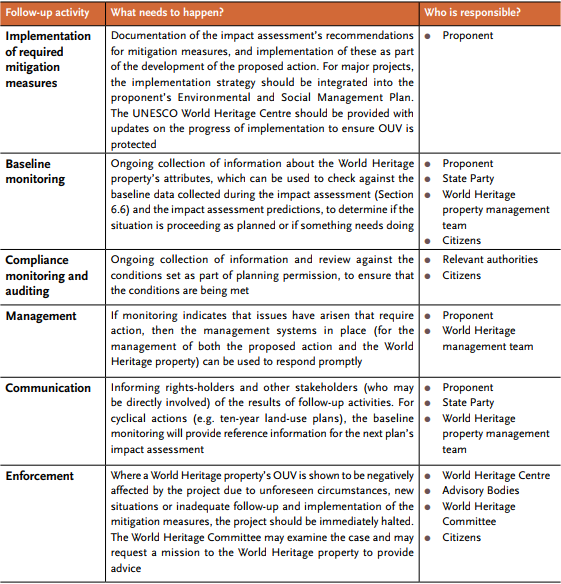Follow-up
Should a proposed action be approved, longer-term follow-up mechanisms will be needed to monitor and implement the mitigation measures necessary to ensure that OUV is protected and any sustainable development objectives are attained (Table 6.4). While those involved at the
World Heritage property
A cultural, natural or mixed heritage place inscribed on the World Heritage List and therefore considered to be of OUV for humanity. The responsibility for nominating a property to the World Heritage List falls upon the State(s) Party(ies) where it is located. The World Heritage Committee decides whether a property should be inscribed on the World Heritage List, taking into account the technical recommendations of the Advisory Bodies following rigorous evaluation processes.
When used as a general term, World Heritage refers to all the natural, cultural and mixed properties inscribed on the World Heritage List.
will not be responsible for all such follow-up activities, their ongoing support is critical to ensure that longterm obligations are met with respect to the protection of OUV.
The impact assessment should indicate necessary conditions – required mitigation measures – for approval, which form the basis for a clear implementation strategy. For a minor project, this could be a simple list of agreed recommendations. For a major project, it could be a draft Environmental and Social Management Plan which is included in the contract documentation for the proposed action. The implementation strategy will guide the development of the proposed action on the ground: it should clearly explain how the impact assessment’s required mitigation measures will be implemented and monitored.
Where a major project is approved, it is good practice for the proponent to draw up an Environmental and Social Management Plan (ESMP) which describes how the project will be implemented in respect of relevant legislation and agreed mitigation measures. Heritage All inherited assets which people value for reasons beyond mere utility. Heritage is a broad concept and includes shared legacies from the natural environment, the creations of humans and the creations and interactions between humans and nature. It encompasses built, terrestrial, freshwater and marine environments, landscapes and seascapes, biodiversity, geodiversity, collections, cultural practices, knowledge, living experiences, etc. institutions and World Heritage All inherited assets which people value for reasons beyond mere utility. Heritage is a broad concept and includes shared legacies from the natural environment, the creations of humans and the creations and interactions between humans and nature. It encompasses built, terrestrial, freshwater and marine environments, landscapes and seascapes, biodiversity, geodiversity, collections, cultural practices, knowledge, living experiences, etc. site management teams should be consulted when an ESMP is drawn up for a project that could affect OUV. Once agreed mitigation measures and other safeguards are included, the ESMP can become a good basis for holding proponents to account, monitoring how the project progresses, and discussing any necessary adjustments as it proceeds (Section 6.14). It is also useful for ensuring everyone involved in the project implementation is aware of the results of the impact assessment, even if they were not part of it.
It is the proponent’s responsibility to ensure that the proposed action causes no negative impacts during its implementation. This will typically be overseen by the environmental and heritage authorities and can be followed by citizens’ committees, joint commissions or other arrangements appropriate to the local governance. The management team for the
World Heritage property
A cultural, natural or mixed heritage place inscribed on the World Heritage List and therefore considered to be of OUV for humanity. The responsibility for nominating a property to the World Heritage List falls upon the State(s) Party(ies) where it is located. The World Heritage Committee decides whether a property should be inscribed on the World Heritage List, taking into account the technical recommendations of the Advisory Bodies following rigorous evaluation processes.
When used as a general term, World Heritage refers to all the natural, cultural and mixed properties inscribed on the World Heritage List.
should review internal monitoring and evaluation processes. The State Party Focal Point can include an update on the project and implementation of the impact assessment’s recommendations in the Periodic Reporting and/or State of Conservation reporting to the UNESCO
World Heritage Centre
The UNESCO World Heritage Centre is a technical administrative body within UNESCO, established in 1992 and appointed by the Director-General of UNESCO. It acts as the Secretariat of the
World Heritage Convention
The Convention Concerning the Protection of the World Cultural and Natural Heritage is an international treaty adopted by the UN in 1972 that defines the kind of natural or cultural sites which can be considered for inscription on the World Heritage List for their Outstanding Universal Value for all humankind. Commonly known as the World Heritage Convention, it establishes how the international community as a whole is responsible for
the protection of such heritage and sets out the duties of States Parties in identifying potential sites that may be eligible for inscription onto the World Heritage List and their role in protecting and preserving them. By signing the Convention, each country pledges to conserve not only the sites situated on its territory that have been recognized as being of Outstanding Universal Value, but also to protect its national heritage and to be involved in international efforts to protect, conserve and promote the heritage of humankind.
, is the focal point and coordinator within UNESCO for all matters related to World Heritage, and ensures the day-to-day management of the Convention.
. This is especially the case where such reporting has been requested by the World Heritage Committee. The impact assessment process can suggest additional areas that may usefully be monitored over time. This not only provides extra checks on the implementation of the proposed action, but it also ensures that more reliable and long-term data are available for the baseline for any other future actions (Section 6.6).

Table 6.4. Follow-up activities after the proposed action has been approved



